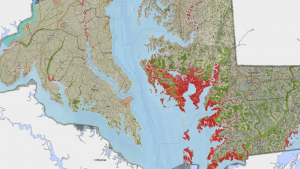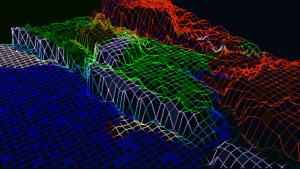Stressors and impacts
Coastal wetland habitats are vital national resources, sustaining fish, wildlife, and plant populations that in turn support fishing economies, improve water quality, provide floodwater storage, and buffer communities from storm impacts. With a projected relative sea level rise of twice the global average, Maryland’s coastal wetlands are particularly vulnerable to episodic storms, coastal flooding, storm surge, and inundation. Land conservation efforts that proactively target areas to allow for the inland movement of coastal habitat can help maintain the indispensable ecosystem services provided by wetlands.
Conservation planning for climate resilience
In 2008, the State of Maryland’s Climate Action Plan identified the need for natural resource protection in the face of sea level rise. The plan recommended that the state identify high-priority protection areas and strategically direct its protection and restoration activities to those areas. The plan also recommended that the state develop and implement a package of appropriate regulations, financial incentives, and educational, outreach, and enforcement approaches to retain and expand forests and wetlands in areas suitable for long-term survival.
Based on the plan’s recommendations, staff with the Maryland Department of Natural Resources (DNR) developed a computerized Green Infrastructure Assessment tool to identify and categorize elements of natural infrastructure. Formalizing definitions and criteria for green infrastructure helped them develop a consistent method for evaluating land conservation and restoration efforts. Similarly, the DNR developed the Blue Infrastructure Near-shore Assessment, a detailed spatial evaluation of coastal habitat, critical natural resources, and associated human uses in the tidal waters and near-shore areas of Maryland’s coastal zone.
Modeling wetland migration
To gain a sense of how the state’s wetlands may migrate in response to sea level rise, a team of DNR personnel modeled the system using the Sea Level Affecting Marshes Model (SLAMM). By incorporating data on wetland size and location, surrounding buffers, and ecosystem connectivity into the model, they identified coastal lands with the highest potential to aid in adaptation if sea level rises a meter per century. They looked for areas of large, contiguous wetlands, high wetland diversity, potential new wetland areas, and habitat conditions required by wetland-dependent birds. They also set criteria to prioritize land that could be conserved into the future, and areas that aligned with Maryland’s Green Infrastructure Assessment and Blue Infrastructure Near-shore Assessment.
Using model results to target ecological areas for conservation
In 2012, areas identified as potential future wetlands through the modelling exercise were incorporated into Maryland’s GreenPrint mapping application, a system that shows lands and watersheds of high ecological value identified as conservation priorities by the DNR. Numeric rankings derived from the Green and Blue Assessments described above are incorporated into conservation scorecards for each parcel of land being considered by the DNR land acquisition and planning team. The scorecards help resource managers make decisions about how to invest limited state funding into the most ecologically important projects.
The U.S. Fish and Wildlife Service, the National Wildlife Federation, the Maryland Environmental Trust, and other coastal land trusts also incorporate considerations of high-priority areas in their land conservation planning and parcel-level reviews to aid in climate change adaptation. Conserving these high-priority areas will enable habitats to shift inland naturally, provide places for wildlife to seek refuge, and aid in protecting developed areas as conditions change in the future.
Results from the wetland migration model have also been incorporated into the GIS-based Maryland Coastal Atlas as the Estuaries Wetland Change Tool. This tool can show the percentage of each county currently classified as various types of wetlands, and how that value may change by 2100 with sea level rise. Projected "New Wetland Areas" for the years 2050 and 2100, based on the SLAMM study, provide insight into potential future wetland migration zones.



